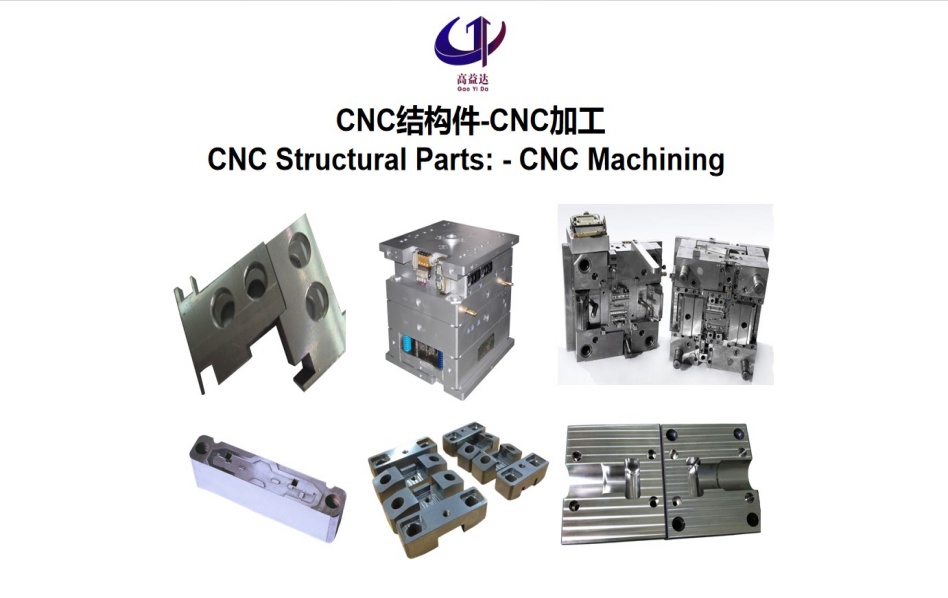CNC加工 CNC machining

一、高精度加工
尺寸精度高:CNC 加工设备能够精确控制刀具的运动轨迹和切削参数,从而实现非常高的尺寸精度。通常情况下,CNC 加工可以将尺寸误差控制在几微米甚至更小的范围内。这使得加工出的零件能够满足各种高精度要求的应用场景,如航空航天、医疗器械、电子设备等领域。
形状精度高:通过精确的编程和刀具路径控制,CNC 加工可以制造出各种复杂形状的零件,并且保证形状精度。无论是曲面、斜面、孔、槽等几何形状,都可以被精确地加工出来。这为产品设计提供了更大的自由度,能够满足各种复杂的设计要求。
位置精度高:CNC 加工能够确保零件上各个特征之间的相对位置精度。例如,孔与孔之间的距离、轴与孔的同轴度等都可以被精确控制。这对于需要进行装配的零件来说非常重要,能够保证装配的准确性和可靠性。
二、高效率加工
自动化程度高:CNC 加工设备通常具有高度自动化的特点,可以实现连续、无人值守的加工过程。操作人员只需进行编程、装夹工件和监控加工过程等工作,大大降低了劳动强度,提高了生产效率。
加工速度快:CNC 加工设备可以根据不同的材料和加工要求选择合适的切削参数,从而实现高速切削。相比传统的加工方法,CNC 加工可以大大缩短加工时间,提高生产效率。
可进行多工序加工:CNC 加工设备通常配备有多种刀具和加工功能,可以在一次装夹中完成多个工序的加工,如铣削、钻孔、镗孔、攻丝等。这不仅减少了装夹次数和加工时间,还提高了加工精度和表面质量。
三、灵活性强
适应不同材料加工:CNC 加工可以适用于各种材料的加工,包括金属、塑料、木材、复合材料等。不同的材料需要不同的切削参数和刀具选择,CNC 加工设备可以根据材料的特性进行调整,实现高效、高质量的加工。
易于实现复杂形状加工:由于 CNC 加工设备可以精确控制刀具的运动轨迹,因此可以轻松地实现各种复杂形状的加工。无论是三维曲面、异形结构还是高精度的细节部分,都可以被精确地加工出来。这为产品设计提供了更大的灵活性和创新空间。
可进行小批量和单件生产:CNC 加工设备不需要制作专用的模具和夹具,因此可以适用于小批量和单件生产。这对于新产品开发、样品制作和个性化定制等需求非常有优势,能够快速响应市场变化和客户需求。
四、质量稳定可靠
加工过程稳定:CNC 加工设备采用计算机数字控制技术,加工过程稳定可靠。刀具的切削参数和运动轨迹可以被精确控制,避免了人为因素对加工质量的影响。同时,CNC 加工设备通常具有良好的刚性和精度保持性,能够在长时间的加工过程中保持稳定的加工质量。
可进行质量检测和控制:CNC 加工设备可以配备各种质量检测装置,如三坐标测量仪、刀具磨损监测系统等。这些装置可以实时监测加工过程中的尺寸精度、形状精度和表面质量等参数,并及时进行调整和控制,确保加工质量的稳定可靠。
一致性好:由于 CNC 加工设备的自动化程度高,加工过程稳定可靠,因此可以保证加工出的零件具有良好的一致性。这对于批量生产来说非常重要,能够提高产品的质量稳定性和可靠性
First, high precision machining
High dimensional accuracy: CNC machining equipment is able to precisely control the tool trajectory and cutting parameters to achieve very high dimensional accuracy. Typically, CNC machining can control the dimensional error within a few microns or even less. This enables the machined parts to meet a variety of application scenarios that require high precision, such as aerospace, medical devices, electronic equipment, and more.
High Shape Accuracy: Through precise programming and tool path control, CNC machining can produce parts with a variety of complex shapes with guaranteed shape accuracy. Whether the geometry is curved, beveled, holes, slots, etc., it can be machined with precision. This provides greater freedom in product design and can meet a wide range of complex design requirements.
High Positional Accuracy: CNC machining ensures relative positional accuracy between features on a part. For example, the distance between holes and the coaxiality of shafts and holes can be precisely controlled. This is very important for parts that need to be assembled to ensure the accuracy and reliability of the assembly.
Second, high-efficiency machining
High degree of automation: CNC machining equipment is usually characterized by a high degree of automation, which can realize continuous, unattended machining process. The operator only needs to carry out programming, clamping workpieces and monitoring the machining process and other work, greatly reducing labor intensity and improving production efficiency.
Fast machining speed: CNC machining equipment can select the appropriate cutting parameters according to different materials and machining requirements, thus realizing high-speed cutting. Compared with traditional machining methods, CNC machining can greatly shorten the processing time and improve productivity.
Multi-process machining: CNC machining equipment is usually equipped with a variety of tools and machining functions, and can complete multiple processes in a single clamping, such as milling, drilling, boring, tapping and so on. This not only reduces the number of clamping and processing time, but also improves the machining accuracy and surface quality.
Third, flexible
Adapt to the processing of different materials: CNC machining can be applied to the processing of a variety of materials, including metal, plastic, wood, composite materials, etc.. Different materials require different cutting parameters and tool selection, CNC machining equipment can be adjusted according to the characteristics of the material to achieve efficient, high-quality processing.
Easy to realize complex shapes: CNC machining equipment can easily realize a variety of complex shapes due to the precise control of the tool's trajectory. Whether it's a three-dimensional surface, a shaped structure or a high-precision detail part, it can be machined with precision. This provides greater flexibility and room for innovation in product design.
Small-lot and single-piece production: CNC machining equipment does not require the creation of specialized molds and fixtures, making it suitable for small-lot and single-piece production. This is very advantageous for new product development, sample production and personalized customization needs, and can quickly respond to market changes and customer demand.
Fourth, stable and reliable quality
Stable machining process: CNC machining equipment adopts computer digital control technology, stable and reliable machining process. The cutting parameters and trajectory of the tool can be precisely controlled, avoiding the influence of human factors on the processing quality. At the same time, CNC machining equipment usually has good rigidity and accuracy retention, and can maintain stable machining quality over a long period of time.
Quality inspection and control: CNC machining equipment can be equipped with a variety of quality inspection devices, such as coordinate measuring machine, tool wear monitoring system. These devices can real-time monitoring of the machining process of dimensional accuracy, shape accuracy and surface quality and other parameters, and timely adjustment and control to ensure stable and reliable machining quality.
Good consistency: Due to the high degree of automation of CNC machining equipment, the machining process is stable and reliable, so it can ensure that the machined parts have good consistency. This is very important for mass production, can improve product quality stability and reliability!


